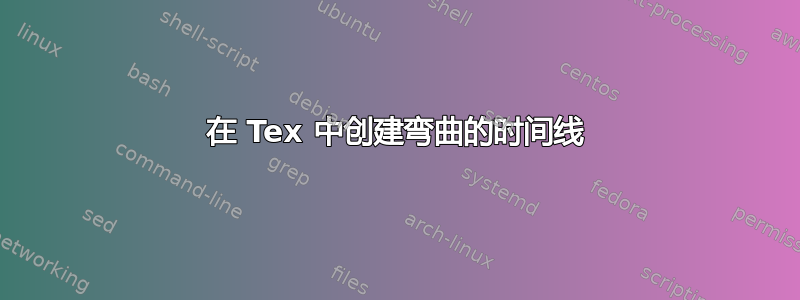
我正在尝试创建一个包含 24 个时间点的时间线,这些时间点以弯曲箭头的形式排列,如下所示:
我有一个直箭头版本(来自@Gonzalo Medina),但它比页面宽度长,所以我想要一个像上面一样的弯曲时间线。我想寻求你的帮助。非常感谢。
\documentclass[a4]{article}
\usepackage[margin=0cm]{geometry}
\usepackage{ragged2e}
\usepackage{tikz}
\usetikzlibrary{chains,shapes.arrows,fit,calc}
\definecolor{arrowcolor}{RGB}{50,130,230}
\definecolor{circlecolor}{RGB}{79,129,189}
\colorlet{textcolor}{white}
\colorlet{bordercolor}{white}
\pgfdeclarelayer{background}
\pgfsetlayers{background,main}
\newcounter{task}
\newlength\taskwidth
\newlength\taskvsep
\setlength\taskwidth{2.5cm}
\setlength\taskvsep{17pt}
\def\taskpos{}
\def\taskanchor{}
\newcommand\task[1]{%
{\parbox[t]{\taskwidth}{\scriptsize\Centering#1}}}
\tikzset{
inner/.style={
on chain,
circle,
inner sep=1pt,
fill=circlecolor,
line width=0.5pt,
draw=bordercolor,
},
on grid
}
\newcommand\Time[2][]{%
\node[inner xsep=0pt] (c1) {\phantom{A}};
\stepcounter{task}
\ifodd\thetask\relax
\renewcommand\taskpos{\taskvsep}\renewcommand\taskanchor{south}
\else
\renewcommand\taskpos{-\taskvsep}\renewcommand\taskanchor{north}
\fi
\node[inner,font=\footnotesize\sffamily\color{textcolor}]
(c\the\numexpr\value{task}+1\relax) {#1};
\node[anchor=\taskanchor,yshift=\taskpos]
at (c\the\numexpr\value{task}+1\relax) {\task{#2}};
}
\newcommand\drawarrow{a
\ifnum\thetask=0\relax
\node[on chain] (c1) {};
\fi
\node[on chain] (f) {};
\begin{pgfonlayer}{background}
\node[
inner sep=10pt,
single arrow,
single arrow head extend=0.5cm,
draw=none,
fill=arrowcolor,
fit= (c1) (f)
] (arrow) {};
\fill[white]
(arrow.before tail) -- (c1|-arrow.east) -- (arrow.after tail) -- cycle;
\end{pgfonlayer}
}
\newenvironment{timeline}[1][node distance=.5\taskwidth]
{\par\noindent\begin{tikzpicture}[start chain,#1]}
{\drawarrow\end{tikzpicture}\par}
\begin{document}
\begin{timeline}
\Time[1958]{Task 1}
\Time[1959]{Task 2}
\Time[1960]{Task 3}
\Time[1961]{Task 4}
\Time[1962]{Task 5}
\Time[1963]{Task 6}
\Time[1964]{Task 7}
\Time[1965]{Task 8}
\Time[1966]{Task 9}
\Time[1967]{Task 10}
\Time[1968]{Task 11}
\Time[1969]{Task 12}
\Time[1970]{Task 13}
\Time[1971]{Task 14}
\Time[1972]{Task 15}
\Time[1973]{Task 16}
\Time[1974]{Task 17}
\Time[1975]{Task 18}
\Time[1976]{Task 19}
\Time[1977]{Task 20}
\Time[1978]{Task 21}
\Time[1979]{Task 22}
\Time[1980]{Task 23}
\Time[1981]{Task 24}
\end{timeline}
\end{document}
參考文獻:我如何制定标准时间表?[社区添加]
答案1
开始...
对于多行箭头,我建议使用
arrows.meta库% p.221 %\usetikzlibrary {arrows.meta} \tikz \draw [line width=1ex, {Triangle Cap[reversed]-{Latex[length=0pt +2]}}] (0,0) -- (1,0);对于标签 task1、task2...我使用
\node alsowithlabel distancein\tikzset
编辑:为了获得更圆润的形状,我使用了circle(带有clip),并在bar arrow#1中添加了 2 个参数以表示开始,在#2中添加了 2 个参数以表示结束。
- 我添加了
\arrowvsep箭头之间的距离的长度
代码
\documentclass[a4paper]{article}
% https://tex.stackexchange.com/questions/715875/create-a-curved-timeline-in-tex
\usepackage[showframe,margin=1cm]{geometry}
\usepackage{tikz}
\usetikzlibrary{arrows.meta}
\usetikzlibrary {positioning}
\usetikzlibrary {chains}
% color
\definecolor{arrowcolor}{RGB}{50,130,230}
\definecolor{circlecolor}{RGB}{79,129,189}
\colorlet{textcolor}{white}
\colorlet{bordercolor}{white}
% length
\newlength\taskwidth
\newlength\taskvsep
\newlength\arrowvsep%<-- added
\setlength\taskwidth{2.cm}
\setlength\taskvsep{1.5ex}
\setlength\arrowvsep{3.cm}
%
\begin{document}
%in th doc p.601
\begin{tikzpicture}[start chain,node distance=5mm]
% The chain is called just "chain"
\draw[help lines] (0,-1) grid (2,1);
\node [on chain] {A};
\node [on chain] {B};
\node [on chain] {C};
\end{tikzpicture}
\vspace{1cm}
\begin{tikzpicture}[start chain,node distance=5mm]
% The chain is called just "chain"
\draw[help lines] (0,-1) grid (2,1);
\node [on chain,circle,draw] {A};
\node [on chain,circle,draw] {B};
\node [on chain,circle,draw] {C};
\end{tikzpicture}
\vspace{1cm}
%\usetikzlibrary {positioning}
\begin{tikzpicture}[start chain,node distance=1cm,on grid]
% The chain is called just "chain"
\draw[help lines] (0,-1) grid (2,1);
\node [on chain,circle,draw] {A};
\node [on chain,circle,draw] {B};
\node [on chain,circle,draw] {C};
\end{tikzpicture}
\vspace{1cm}
\begin{tikzpicture}[start chain=1 going right,
start chain=2 going left,
node distance=5mm,
every node/.style=draw]
\draw[help lines] (0,-2) grid (3,1);
\node [on chain=1] {A};
\node [on chain=1] {B};
\node [on chain=1] (C){C};
\node [on chain=2] at ([shift={(0.5cm,-1cm)}]C) {0};
\node [on chain=2] {1};
\node [on chain=2] {2};
\end{tikzpicture}
\vspace{1cm}
% p.221
%\usetikzlibrary {arrows.meta}
\tikz \draw [line width=1cm,
{Triangle Cap[reversed]-{Latex[length=0pt +2]}}]
(0,0) -- (5,0);
\begin{tikzpicture}
\draw [line width=1cm,
{Triangle Cap[reversed]-}]
(0,0) -- (5,0);
\begin{scope}
\clip (5,-3) rectangle (6.5,1.5);
\draw[line width=1cm] (5,-1) circle[radius=1cm];
\end{scope}
\draw [line width=1cm,
-{Latex[length=0pt +2]}]
(5,-2) -- (0,-2);
\end{tikzpicture}
\tikzset{
node distance=1.5cm,
on grid,
bar height/.initial=1.2cm,
bar arrow/.style args={#1/#2}%
{%
#1-#2,
arrowcolor,
line width=\pgfkeysvalueof{/tikz/bar height},
%rounded corners=5mm
},
inner/.style=
{
%on chain,
circle,
inner sep=1pt,
minimum width=1cm,
fill=circlecolor,
line width=0.5pt,
draw=bordercolor,
font=\footnotesize\sffamily\color{textcolor},
},
label distance=\taskvsep
}
\vspace{1cm}
\noindent\centering
\fbox{%<--- comment on the final document
\begin{tikzpicture}
[%
trim left=-1.5cm,% begin of the arrow at -1.5
start chain=1 going right,
start chain=2 going left,
]
\draw[help lines] (0,0) grid (15,-4);%<-- comment in the final doc
% \draw[bar arrow] (-1.5,0) -- (15,0) -- ++(0,-\arrowvsep)--(-1.5,-\arrowvsep);
\draw[bar arrow={Triangle Cap[reversed]/{}}] (-1.5,0) -- (14,0);
\begin{scope}
\clip (14,-3.7) rectangle (16.2,1.5);
\draw[bar arrow={{}/{}}] (14,-0.5\arrowvsep) circle[radius=0.5\arrowvsep];
\end{scope}
\draw[bar arrow={{}/{{Latex[arrowcolor, length=0pt +2]}}}] (14,-\arrowvsep) -- (-0.5\arrowvsep,-\arrowvsep);
\foreach \i/\d in{
1/1958,
2/1958,
3/1960,
4/1961,
5/1962,
6/1963,
7/1964,
8/1965,
9/1966,
10/1967}
{
\node[inner,on chain=1] (N_\i) {\d};
\node also [label=\ifodd\i above\else below\fi:task\i] (N_\i);
}
\node [on chain=2] at ([shift={(1cm,-\arrowvsep)}]N_10) {};
\foreach \i in{11,...,19}
{
\node[inner,on chain=2] (N_\i) {Date\i};
\node also [label=\ifodd\i below\else above\fi:task\i] (N_\i);
}
\end{tikzpicture}%
}
\end{document}
答案2
我喜欢这种类型的图形,并且发现它适合我用于打印大量标签的解决方案,路径从尾部开始分部分绘制到头部,当连续number of sections达到特定值时,绘制相应的曲线并沿相反方向绘制部分,完成后,将部分数翻倍,绘制另一条曲线并重置计数器,从而使路径自动增长,最后停止头部,必须根据文本数据的输入来调节绘图,当文本是时,它不是绘制身体而是绘制头部,end在这种情况下,有2个选项,如果它是去还是回,如果它是返回,则必须放置reverse,以便它将头部绘制在相反的方向,通过制作这个,我学到了很多东西,从这里和那里获取东西,这就是我分享它的原因,也因为周末在家。
我之所以进行这种类型的代码组织,是因为数据可以按行排序,并且在生成标签的情况下,我可以使用数据表(例如 Excel)快速获取它们,例如,在最终的框中导出它们各自的 tikz 代码格式。
我让聊天机器人完成了一些包含特定主题的文本,我希望它们不会让人感到不舒服。
梅威瑟:
\documentclass[tikz,border=1cm]{standalone}
\usepackage{ifthen}
\usepackage{helvet}
\definecolor{arrowcolor}{RGB}{50,130,230}
\begin{document}
\def\NTsize{\sf\bfseries\normalsize}
\def\CTsize{\sf\bfseries\normalsize}
\def\BODY#1#2#3#4#5#6#7#8#9{
\begin{scope}[shift={(#1)},rotate=0,transform shape]
\ifthenelse{\equal{#2}{end}}{%Draw The end Arrow Head
\ifthenelse{\equal{#3}{reverse}}{
\filldraw[#6]%Reversed Arrow
(-1pt,#5*0.5+#7/2)
-- ++(#4*0.5+1pt,0)
-- ++ (0,3mm)
-- (#4,#5*0.5)
-- (#4*0.5,#5*0.5-#7/2-3mm)
-- ++(0,3mm)
-- ++(-#4*0.5-1pt,0);
}{
\filldraw[#6]%Normal Arrow
(#4+1pt,#5*0.5+#7/2)
-- ++(-#4*0.5-1pt,0)
-- ++ (0,3mm)
-- (0,#5*0.5)
-- (#4*0.5,#5*0.5-#7/2-3mm)
-- ++(0,3mm)
-- ++(#4*0.5+1pt,0);
}
}{% Draw the normal body
\filldraw[#6] (0,#5*0.5+#7/2) rectangle ++(#4,-#7);
\draw[white](#4*0.5,#5*0.5) node[circle,draw,fill=#6!70!black, minimum size=#7-3mm,font=\NTsize](temp){#2};
\draw(temp)+(#8:#9) node[text width=#4-3mm, align=center,font=\CTsize](t2){#3};
\draw[#6!40!white, preaction={draw,#6, line width=2pt}](temp)--(t2);
}
\end{scope}
}
\def\TAIL#1#2#3#4#5{
\begin{scope}[shift={(#1)}]
\filldraw[#4] (#2+1pt,#3*0.5+#5/2)-- ++(-#2*0.5-1pt,0) -- (#2*0.75,#3*0.5) -- (#2*0.5,#3*0.5-#5/2) -- ++ (1pt+#2*0.5,0);
\end{scope}
}
\def\CURVE#1#2#3#4#5#6{
\begin{scope}[shift={(#1)},#4,transform shape]
\filldraw[#5](-1pt,#3*0.5-#6/2) -- ++(1pt,0) arc (90:-90:#3*0.5-#6/2) -- ++(-1pt,0)-- ++(0,-#6) -- ++(1pt,0) arc (-90:90:#3/2+#6/2)--++(-1pt,0);
\end{scope}
}
\def\SNAKETEXT#1(#2)[#3][#4][#5]#6#7{%\SNAKETEXT{Contents}(Position)[x_dim][y_dim][colour]{tasks_per_line}{arrow size}
\begin{scope}[shift={(#2)}]
\edef\Shiftx{0}
\edef\Shifty{0}
\pgfmathparse{int(#6*2)}
\xdef\tpl{\pgfmathresult}
\foreach \cod/\direc/\dist/\desc [count=\ctr from 0] in {#1}{
\ifnum\ctr=0
\TAIL{\Shiftx*#3,-\Shifty*#4-#4}{#3}{#4}{#5}{#7}
\fi
\ifnum\ctr<#6
\pgfmathparse{int(\Shiftx+1)}
\xdef\Shiftx{\pgfmathresult}
\BODY{\Shiftx*#3,-\Shifty*#4-#4}{\cod}{\desc}{#3}{#4}{#5}{#7}{\direc}{\dist}
\fi
\ifnum\ctr=#6
\pgfmathparse{int(\Shiftx+1)}
\xdef\Shiftx{\pgfmathresult}
\CURVE{\Shiftx*#3,-\Shifty*#4-#4}{#3}{#4}{}{#5}{#7}
\pgfmathparse{int(\Shiftx-1)}
\xdef\Shiftx{\pgfmathresult}
\pgfmathparse{int(\Shifty+1)}
\xdef\Shifty{\pgfmathresult}
\BODY{\Shiftx*#3,-\Shifty*#4-#4}{\cod}{\desc}{#3}{#4}{#5}{#7}{\direc}{\dist}
\fi
\ifnum\ctr>#6
\ifnum\ctr<\tpl
\pgfmathparse{int(\Shiftx-1)}
\xdef\Shiftx{\pgfmathresult}
\BODY{\Shiftx*#3,-\Shifty*#4-#4}{\cod}{\desc}{#3}{#4}{#5}{#7}{\direc}{\dist}
\fi
\fi
\ifnum\ctr=\tpl
\pgfmathparse{int(\Shiftx-1)}
\xdef\Shiftx{\pgfmathresult}
\CURVE{\Shiftx*#3+#3,-\Shifty*#4-#4}{#3}{#4}{xscale=-1}{#5}{#7}
\pgfmathparse{int(\Shifty+1)}
\xdef\Shifty{\pgfmathresult}
\pgfmathparse{int(\Shiftx+1)}
\xdef\Shiftx{\pgfmathresult}
\BODY{\Shiftx*#3,-\Shifty*#4-#4}{\cod}{\desc}{#3}{#4}{#5}{#7}{\direc}{\dist}
\xdef\ctr{0}
\fi
}
\end{scope}
}
\begin{tikzpicture}
\SNAKETEXT{
task1/90/20mm/Detail of task 1,
task2/-90/20mm/Detail of task 2,
task3/90/20mm/Detail of task 3,
task4/-90/20mm/Detail of task 4,
task5/90/23mm/Some manual text input for more details,
task6/-90/23mm/Become a Professional Procrastinator,
task7/90/20mm/Organize Your Clutter,
task8/-90/20mm/Master the Art of Napping,
task9/90/20mm/Attend a Productivity Seminar,
task10/-90/23mm/Create a To-Do List for Doing Nothing,
task11/-90/20mm/Practice Active Inactivity,
task12/90/20mm/Become an Expert at Waiting,
task13/-90/20mm/Write a Book on Doing Nothing,
task14/90/20mm/Achieving Zen in Pajamas,
task15/-90/20mm/Watch 10 Hours of Cat Videos,
task16/90/23mm/Reorganized My Sock Drawer Instead of Studying,
task17/-90/30mm/Dedicate hours each day to scrolling through social media feeds.,
task18/90/25mm/Spend hours contemplating the meaning of life,
task19/-90/20mm/Some task like doing nothing,
end/end/end/end%
}(0,0)[25mm][50mm][arrowcolor]{10}{20mm}
%Changing the font sizes
\def\NTsize{\sf\bfseries\scriptsize}
\def\CTsize{\sf\bfseries\scriptsize}
\SNAKETEXT{
JAN-30/-90/15mm/Polar Bear Plunge Day,
FEB-29/90/15mm/International Lost Sock Memorial Day,
MAR-13/-90/15mm/Global Labyrinth Day,
APR-30/90/15mm/National Awkward Silence Appreciation Day,
MAY-15/-90/15mm/World Emoji Day,
JUN-07/-90/15mm/National Talk Like a Pirate Day,
JUL-15/90/15mm/Global Prohibition Day,
AUG-12/-90/15mm/National Overthinking Awareness Weeky,
SEP-06/90/15mm/World Couch Potato Championship,
OCT-17/-90/15mm/National Socks-with-Sandals Day,
NOV-28/-90/15mm/ Global Pajama Conference,
DEC-25/90/15mm/World Simultaneous Eye Roll Day ,
end/end/end/reverse%
}(0,-13)[25mm][30mm][green!50!black]{5}{15mm}
%Changing the font sizes
\def\NTsize{\sf\bfseries\tiny}
\def\CTsize{\sf\bfseries\tiny}
\SNAKETEXT{
A/90/5mm/cmt-stg1,
B/90/5mm/cmt-stg2,
C/90/5mm/cmt-stg3
D/90/5mm/cmt-stg4,
E/90/5mm/cmt-stg5,
F/90/5mm/cmt-stg6,
G/90/5mm/cmt-stg7,
H/90/5mm/cmt-stg8,
I/90/5mm/cmt-stg9,
J/90/5mm/cmt-stg10,
K/90/5mm/cmt-stg11,
L/90/5mm/cmt-stg12,
M/90/5mm/cmt-stg13,
N/90/5mm/cmt-stg14,
M/90/5mm/cmt-stg15,
O/90/5mm/cmt-stg16,
end/end/end/end%
}(18,-11)[20mm][10mm][cyan!50!green]{2}{5mm}
%Changing the font sizes
\def\NTsize{\sf\bfseries\tiny}
\def\CTsize{\sf\bfseries\tiny}
\SNAKETEXT{
A/90/5mm/cmt-stg1,
B/90/5mm/cmt-stg2,
C/90/5mm/cmt-stg3
D/90/5mm/cmt-stg4,
E/90/5mm/cmt-stg5,
F/90/5mm/cmt-stg6,
G/90/5mm/cmt-stg7,
H/90/5mm/cmt-stg8,
I/90/5mm/cmt-stg9,
J/90/5mm/cmt-stg10,
K/90/5mm/cmt-stg11,
L/90/5mm/cmt-stg12,
M/90/5mm/cmt-stg13,
N/90/5mm/cmt-stg14,
M/90/5mm/cmt-stg15,
O/90/5mm/cmt-stg16,
P/90/5mm/cmt-stg17,
Q/90/5mm/cmt-stg18,
end/end/end/reverse%
}(24,-11)[20mm][10mm][red!50!blue]{2}{5mm}
\end{tikzpicture}
\end{document}





